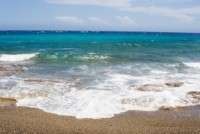Understanding freak waves

(PhysOrg.com) -- Rogue waves, once considered nothing more than a sailor’s myth, are more predictable than ever thanks to new research from the oceanography team at Swinburne University of Technology.
Dr Alessandro Toffoli, who lectures in water, port engineering and oceanography, has shown that rogue waves – or ‘freak waves’, as they are often referred to in the media – are more likely to occur when a wave formation enters a current travelling in the opposite direction.
Rogue waves are giant waves that can occur without warning, often towering two or three times higher than other waves around it. Recently a 26.5 metre rogue wave – about the size of a 10-storey building – was detected in a 10-metre sea.
Toffoli, who collaborated on the paper, Triggering rogue waves in opposing currents, with Dr Miguel Onorato and Dr Davide Proment from the Università degli Studi di Torino in Italy, found that when a stable group of waves enters an ocean current, it can trigger an instability process that causes one wave in the group to rapidly increase in size.
For a rogue wave to occur, Toffoli said a number of conditions must be met. The direction of the waves and direction of the current, the velocity of both, and the change in velocity of the current field, are all factors contributing to the formation of a rogue wave.
As an example, Toffoli said a wave system travelling from the Southern Ocean to the east coast of Australia had the potential to form a rogue wave as it entered the south-travelling East Australian Current (EAC). A swell with a period of about 12 seconds interacting with the EAC may increase its height by up to 60 per cent, while storm waves can increase by up to 100 per cent.
Rogue waves often occur far out to sea and are similar to wind-generated waves - they are hundreds of metres long and can be tens of metres high - and are therefore very steep. They are different to tsunamis, which are generated by earthquakes and are hundreds of kilometres long in the open ocean, and are not steep.
Rogue waves were thought to be a myth until recently, when off-shore platforms and satellite tracking confirmed their existence.
“Ten, 20 years ago, mariners would say a ship was sunk by a rogue wave and no one would believe it,” Toffoli said.
“Lately there has been advancement in the field. We understand that rogue waves can occur, and now we are beginning to understand why they occur.”
Toffoli said his research could be used to improve forecasting rogue waves, which could help the offshore and shipping industries.
“The work we’ve done is very much theoretical, in principle it can be applied in off-shore engineering, for example. As we’re predicting rogue waves, that has safety implications for marine operations, but it can also help design practices, to properly account for the wave-load on structures.”
The research could also improve navigational software, which could suggest alternative routes for ships based on the likelihood of a rogue wave occurring.
Toffoli said his research can also be applied to other fields of physics, such as nonlinear optics, where the instability of wave packets is important.
Toffoli’s paper has been accepted for publication in the prestigious Physical Review Letters. (see hdl.handle.net/1959.3/203690)
Provided by Swinburne University of Technology


















